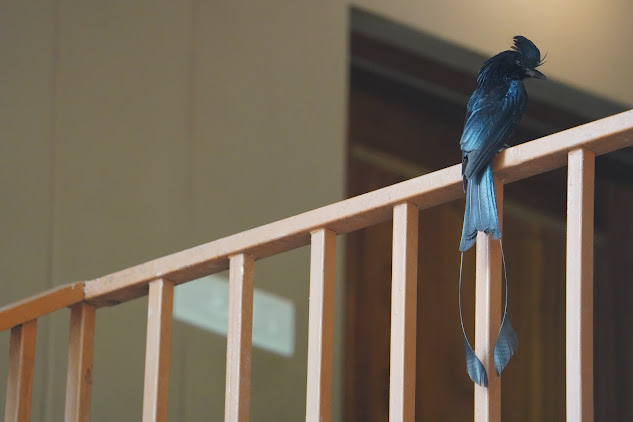Meet the Mimicry Artist 😊
The Greater Racket-tailed Drongo
#intothewildwithrufus
He came and perched himself quite elegantly on the railings of our balcony, and waited patiently, until I was done with my snapshots of him. This was in Pench, Madhya Pradesh.
Well, the Racket-tailed Drongo has some strikingly unique features –
Firstly, unlike most other birds, both male and female Greater Racket-tailed Drongos share the same striking glossy black plumage. That is, they don’t exhibit sexual dimorphism.
Secondly, (unlike other drongos) their outer tail feathers are greatly elongated and have a peculiar twist just above the tip, which is ‘racket-like’, and hence their name.
Thirdly, yet another striking feature is their prominent crest of curled feathers that begins in front of the face above the beak and extends along the crown.
Fourthly, these Racket-tailed Drongos are renowned for their incredible ability to mimic the calls of a wide variety of other bird species, especially predators.
This helps them with kleptoparasitism (food stealing), wherein, they mimic the alarm calls of predators (like hawks or eagles) to trick them into dropping their freshly caught prey or fleeing, allowing the drongo to swoop in and steal the meal.
Finally, both male and female participate equally in their parental responsibilities like nesting duties (which includes nest construction), incubation, and rearing their young ones.
These birds have very wide and widespread distribution across India, particularly in the Western Ghats, and also across South and Southeast Asia.
In their exciting book on
birds, titled, Birds of the Indian Subcontinent, Richard Grimmett et al give
their submissions on this mimicry artist!
Here goes -
Widespread resident; unrecorded in Pakistan. ID Adult from Lesser Racket-tailed Drongo (where ranges overlap) by larger size and less tidy appearance. larger bill, crested head, forked tail, and longer. twisted tail-rackets.
Tail-streamers and rackets can be missing or broken, and tail can appear almost square-ended when in moult (or in juvenile plumage).
Juvenile initially lacks rackets; is less heavily glossed than adult. and has much-reduced crest.
Has white fringes to belly and vent in firstwinter plumage. Considerable subspecies variation in size. length of tail-streamers and size of crest.
Subspecies in S India, Sri Lanka and Andaman and Nicobar Is have much-reduced or almost nonexistent crest and can look very like Lesser Racket-tailed (but Lesser does not occur in these areas).
Voice: Loud, varied musical whistling. screeching and churring. with much mimicry. HH Broadleaved forest and bamboo jungle.
Source
Grimmett, Richard et al. Birds of the Indian Subcontinent. London, Bloomsbury, 2014. p.278






No comments:
Post a Comment